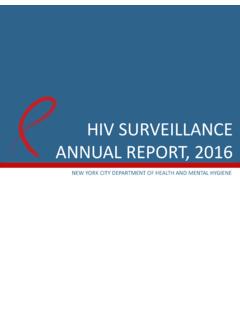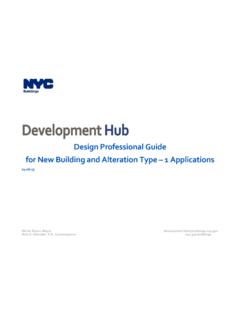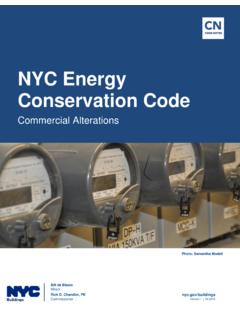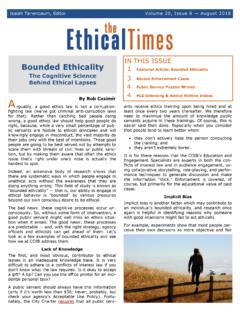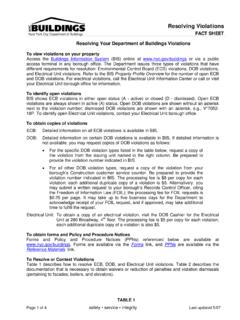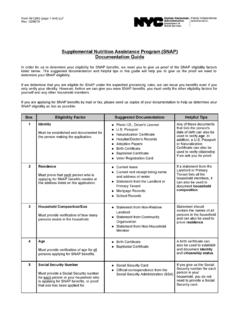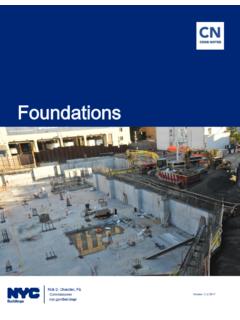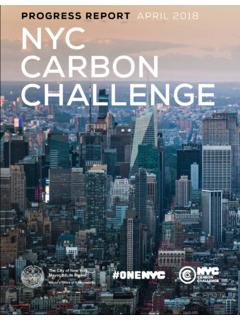Transcription of ALIGNING NEW YORK CITY WITH THE PARIS CLIMATE …
1 The City of New YorkMayor Bill de BlasioAnthony Shorris First Deputy MayorALIGNING NEW YORK CITY WITH THE PARIS CLIMATE AGREEMENT CALIGNING NEW YORK CITY WITH THE PARIS CLIMATE AGREEMENT CMESSAGE FROM THE MAYORF riends, In New York City, we have known for some time that we have to address the existential crisis of CLIMATE change. Superstorm Sandy showed us the terrible cost of our warming planet. We had hoped we could depend on the federal government for leadership. Now we know we cannot. President Trump s decision to pull the United States out of the PARIS CLIMATE Agreement has set us on a dangerous path of denial.
2 The City of New York was already taking action to reduce emissions 80 percent by 2050. Now, we have to take matters into our own hands and go further. That is why on June 2, 2017, I signed Executive Order 26 committing New York City to the principles of the PARIS Agreement, which seeks to limit global temperature rise to degrees Celsius. I have directed all agencies of City government to develop their own plans to accelerate our 80 x 50 efforts and bring us in line with the PARIS Agreement. This plan is the first of its kind and lays out the pace, scale, and impact of the work we must do by 2020 to achieve this goal.
3 It also commits us to work with other cities to develop a protocol to reduce our carbon footprint to our national government falls down, local governments have to step up. I am proud that New York City will play its part and that we are joining in common cause with hundreds of local governments around this nation and the world. Together, we will show that the people will solve this problem at the grassroots. mayor Bill de BlasioSeptember C: ALIGNING New York City with the PARIS CLIMATE Agreement is published pursuant to Executive Order 26 of 2017. This document was produced by the New York City mayor s Office of | ContentsINTRODUCTION5 NYC S 2020 CLIMATE ACTIONS8 REDUCED AND MORE EFFICIENT CONSUMPTION9 TRANSITION TO CLEAN ENERGY12 CLIMATE CHANGE LEADERSHIP142020 CLIMATE ACTIONS DASHBOARD16 GHG IMPACT OF 2020 CLIMATE ACTIONS26 IMPLEMENTING 2020 CLIMATE ACTIONS28WE CAN T DO IT ON OUR OWN30 CONCLUSION31 APPENDIX I: AGENCY HIGHLIGHTS32 APPENDIX II: EXECUTIVE ORDER 2641 APPENDIX III: 2016 GHG INVENTORY42 APPENDIX IV.
4 METHODOLOGY58 ACRONYMS62 ACKNOWLEDGEMENTS63 ENDNOTES63 MESSAGE FROM C40 CITIES EXECUTIVE DIRECTORIn December 2016, C40 and Arup published Deadline 2020: How Cities Will Get the Job Done, which quantified the contribution that mayors can make to deliver the goals of the PARIS CLIMATE Agreement. Our conclusion was that it is still possible to prevent runaway CLIMATE change limiting temperature rise to no more than degrees Celsius above the pre-industrial average but to do so global city emissions have to peak by 2020, then decline to an average of three metric tons CO2e per capita by 2030, and hit zero by those targets is now C40 s number one goal, not least because we also calculated that if every city with a population over 100,000 followed the 91 C40 cities example, it would deliver 40 percent of the emissions reductions needed to achieve the global PARIS Agreement goal.
5 C40 s mayoral Steering Committee subsequently agreed that to remain a C40 member, each city must have published a plan and deliver against those Deadline 2020 targets by the end of 2020 turning the aspirations of the PARIS Agreement into urban congratulate mayor de Blasio and his team on reaching that goal. C: ALIGNING New York City with the PARIS CLIMATE Agreement is a world-leading example of evidence-based, integrated and ambitious CLIMATE action planning and has been reviewed as compatible with C40 s emerging Deadline 2020 CLIMATE Action Planning all around the world will be inspired by New York City s example and C40 looks forward to encouraging them to learn from it, as well as to share back with New York great ideas from other cities that are every day being shared and copied within our network.
6 Mark WattsSeptember 2017 4 | | 5 ALIGNING NEW YORK CITY WITH THE PARIS CLIMATE AGREEMENTWhy ?The PARIS CLIMATE Agreement ( PARIS Agreement), signed by nearly every country, commits signatories to limit global temperature rise to well below 2 degrees Celsius ( F) and to aspire to limit global temperature rise to degrees Celsius ( F). New York City s Executive Order 26, signed by mayor de Blasio on June 2, 2017, commits the City to develop a pathway to achieve the greenhouse gas (GHG) emissions reductions necessary to align with the principles of the PARIS Agreement and a degree Celsius outcome.
7 The difference between current global warming trends and a degree Celsius outcome may seem inconsequential, but the difference in impacts would be dramatic. If the world collectively limits warming to degrees, we will see reduced impacts from CLIMATE change relative to the risks we face in a warmer example, current CLIMATE projections from the NYC Panel on CLIMATE Change show that: NYC faces increased sea level rise, flooding, precipitation, and a greater frequency of more intense storms from CLIMATE change. This will result in heightened risks for residents, buildings, and public infrastructure.
8 By the 2050s, high-end projections show sea levels may rise by up to 30 inches, and average annual precipitation may increase as much as 13 percent. If CLIMATE change goes unabated, NYC can expect increased average temperatures and frequency of heat-waves that would change the livability of the city and put vulnerable populations further at risk. On the high-end for the 2050s, average temperatures are projected to rise by up to F ( C) in the NYC metropolitan region, and the area could see as many as seven heat waves per with a degree Celsius outcome is about preventing the worst projected CLIMATE impacts, both locally and globally.
9 The actions necessary to ensure a degree Celsius outcome will mean a future where New Yorkers can breathe cleaner air, live in more comfotable homes, enjoy access to safe and diverse modes of sustainable transportation, and reside in a city resilient to severe weather effects. This is the NYC we are building June 1, 2017, President Trump announced his intention to withdraw the United States from the PARIS CLIMATE Agreement ( PARIS Agreement), abdicating American leadership on CLIMATE change, one of the most significant challenges facing humanity. The next day, mayor de Blasio signed Executive Order 26, committing the most populous city in the United States to the principles of the PARIS Agreement and to developing a pathway to advance the PARIS Agreement goal of limiting global temperature rise to degrees Celsius.
10 Hundreds of other cities and institutions followed suit by reiterating their commitment to reduce greenhouse gas (GHG) emissions sending a profound signal to the world that the majority of Americans will not retreat from this existential fight. The success of the PARIS Agreement hinges now more than ever on the involvement of cities like New York to put their resources, innovation, and leadership into play. To prevent the worst impacts of CLIMATE change, cities across the planet must dramatically reduce their GHG emissions to limit the increase in the global average temperature to well below 2 degrees Celsius above pre-industrial levels, and reach even further to support the collective effort to limit temperature rise to less than degrees Celsius.
